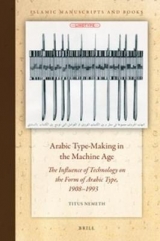Arabic Type-Making in the Machine Age
Arabic is the third most widely used script in the world, and gave rise to one of the richest manuscript cultures of mankind. Its representation in type has engaged printers, engineers, businesses and designers since the 16th century, and today most digital devices render Arabic type. Yet the evolution of the printed form of Arabic, and its development from metal to pixels, has not been charted before. Arabic Type-Making in the Machine Age provides the first comprehensive account of this history using previously undocumented archival sources. In this richly illustrated volume, Titus Nemeth narrates the evolution of Arabic type under the influence of changing technologies from the perspective of a practitioner, combining historical research with applied design considerations.
Titus Nemeth, Ph.D. (Reading, 2014), is a type designer and historian. He has published articles on Arabic type history, and design. His practice revolves around type-making and typography, with a focus on the Arabic script.
Note on Typographical Conventions
Note on Terminology
List of Archives
List of Figures
List of Tables
Acknowledgements
1 Introduction
Arabic Type in the New Millennium
Situating this Book
Aspects of the Arabic Script
The Typographic Representation of the Arabic Script
Arabic Publishing at the Turn of the Twentieth Century
2 Mechanical Composition of Arabic
The Industrialisation of Printing
The Beginning of Arabic Mechanical Composition
Mergenthaler Linotype’s First Arabic Linecaster Founts
The Beginning of Arabic Type-Making at Linotype & Machinery
The Arabic Typewriter
Arabic Script Reform
Nasri Khattar’s Endeavours in Arabic Type Design
Ahmed Lakhdar Ghazal and the Asv Codar Type
The Printing Trade and the Middle East after the Second World War
Simplified Arabic, Kamel Mrowa, and Al-Hayat
Simplified Arabic: Proof of Concept
Intertype Abridged Arabic
A New Design: Series 8 with 9
Monotype Hot-Metal Composition
Monotype’s First Arabic Typeface: Series 507
A Design for Urdu
A New Typeface for the Middle East
Monotype Series 549, the Unwitting Mechanisation of Qurʾān Typography
Monotype Series 589, Full Vocalisation
The Beginning of Computer-Aided Arabic Composition
The Development of Character Selection and Kashida Insertion Routines
3 Photocomposition: Towards Immaterial Type
Beginnings of a New Technological Era
Arabic on the Monophoto
Expansion of Monotype’s Arabic Type Catalogue
Simplified Arabic for Monophoto
Arabic on Linotype Photocomposition Machines
Towards an Arabic Photocomposition Programme
Arabic Type Developments by Linotype-Paul Ltd.
A Widening Field, the Emergence of New Developers
Arabic Type by the Photon Company
Endeavours in Arabic Type by Dr Edward Plooij
4 Persian Type and Typography
Early Persian Printing and Typography
A Simplified Typeface for Persian
Mitra and Nazanin, the Consolidation of a Persian Typographical Identity
5 Beginnings of Digital Arabic Type
Type Loses its Material Properties
Pierre MacKay and Computer-generated Arabic Type
The KITAB Software for the Hell Digiset
Compugraphic’s Venture into Arabic Type
Digital Tools in the Service of the ‘Hanging’Styles Nastaʿlīq and Ruqʿä
Nastaʿlīq on the Monotype Lasercomp
Linotype Ruq’ah, the Exploration of a Writing Style
Linotype Sheeraz, a New Approach to Arabic Type
6 Looking Forward: PostScript and Beyond
The End of Machine-dependence
Linotype’s Arabic PostScript Programme
Upheaval and Convergence, on the Road to Unicode
Desktop Publishing Tools for Arabic
DecoType
7 Complexities and Simplifications: Factors in the Evolution of Arabic Type-Making
Progress through Technology
Collaboration between East and West
Cultural Identity Expressed through Type
Radical Innovation and its Limits
Did Technological Advances Improve Arabic Type ?
Epilogue: Arabic Type-Making Today
Annex 1
Annex 2
Bibliography
Published Sources
Patents
Online Sources
Unpublished Sources
Index
People
Subjects
| Erscheinungsdatum | 03.02.2018 |
|---|---|
| Reihe/Serie | Islamic Manuscripts and Books ; 14 |
| Verlagsort | Leiden |
| Sprache | arabisch; englisch |
| Maße | 155 x 235 mm |
| Gewicht | 961 g |
| Themenwelt | Kunst / Musik / Theater ► Design / Innenarchitektur / Mode |
| Geschichte ► Allgemeine Geschichte ► Neuzeit (bis 1918) | |
| Geisteswissenschaften ► Geschichte ► Regional- / Ländergeschichte | |
| Informatik ► Grafik / Design ► Desktop Publishing / Typographie | |
| Technik | |
| ISBN-10 | 90-04-30377-4 / 9004303774 |
| ISBN-13 | 978-90-04-30377-5 / 9789004303775 |
| Zustand | Neuware |
| Haben Sie eine Frage zum Produkt? |
aus dem Bereich




